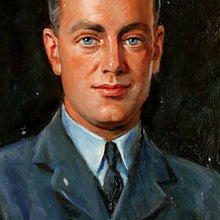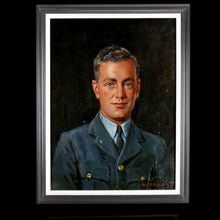Portrait of an Airman - Frank E. Beresford, 1942
- Regular price
- £1,250
- Sale price
- £1,250
- Regular price
-
- Unit price
- /per
Adding product to your cart
Overall: 46cm (18.1in) x 35.5cm (14in)
Oil on board. Quarter length looking forward in Second World War RAF service dress. Signed and dated lower right ‘Frank E Beresford / 1942’. Inscribed verso.
Read more
Frank Ernest Beresford (1881-1967) served as an instructor in the Home Guard and as an official War Artist for the RAF. He was also accredited to the United States Army and United States Army Air Force. For three years he painted and sketched on air stations across Britain (often rising at dawn to paint military aircraft) including depictions of RAF, USAAF,, Dutch and Polish air crews. At the end of the war, he received an Exceptional Service Award from the USAAF., only once before granted to a British subject. His many wartime commissions included a portrait of the Spitfire designer R.J. Mitchell; ‘Demolition of the Blitzed House of Commons’ (1945), being a powerful rendering of the remains of the House of Commons Chamber destroyed by enemy action on 10-11 May 1941; and ‘Deep Effort to Regensburg’ (1943), a depiction of US B-17 bombers flying over the Alps.
Frank Beresford was born in Derby in 1881 and trained at the Derby School of Art (1895-1900), the Académie Carmen (Paris), St John's Wood Art Schools (1900-1901) and the Royal Academy Schools (1901-1906). Between 1906 and 1908, Beresford was elected to a British Institution Scholarship and embarked on a 30,000 mile, 18-month-long international painting tour, during which he attended the Meiji Emperor’s annual tea party in Tokyo. Before the Great War, Beresford also designed murals for St Bartholomew the Great Church, Smithfield and received an art award from the Japanese Government (1909).
In the Great War (1914-1918) Beresford joined the London Regiment and served as an instructor, rising to the rank of Sergeant-Major. A regular exhibitor at the Royal Academy, he was an early member of the United Society of Artists (founded 1921) and of the New Society of Artists. His popular oil canvas portraits, painted in his St John’s Wood studios, resulted in a career spanning six decades. A natural salesman, he received over 3,000 individual commissions from royalty, aristocracy, ex-civic leaders and politicians, senior army officers, society figures, celebrities and industrialists. His many oil paintings of historical events included the famous: The Princes' Vigil: 12.15am, January 28 1936, (1936), depicting George V lying in state in Westminster Hall. Exhibited to great acclaim at the Royal Academy, the picture – which took Beresford 37 hours to paint at the scene - was later bought by his widow, Queen Mary. In the inter-war years, Beresford also specialised in interiors, animals, landscapes, aircraft and murals. He was married to artist Daisy Radcliffe Clague until her death in 1939.
With his pre-war reputation as a royal painter, Beresford was subsequently commissioned to paint the lying in state of George VI (1952) and Queen Mary (1953), although the Royal Academy declined to exhibit them. He also painted The Morning Ride, featuring Princesses Elizabeth and Margaret. In 1949, he was married for the second time to Beres Evelyn Pym, producing two daughters. Beresford was an extremely well-travelled artist, including a 14-month painting tour to South Africa (where he painted General Jan Smuts) and of Rhodesia. An account of his life was written in 2008 by biographer John Fineran: ‘Frank E. Beresford: Indomitable Self Belief 1881-1967’.






